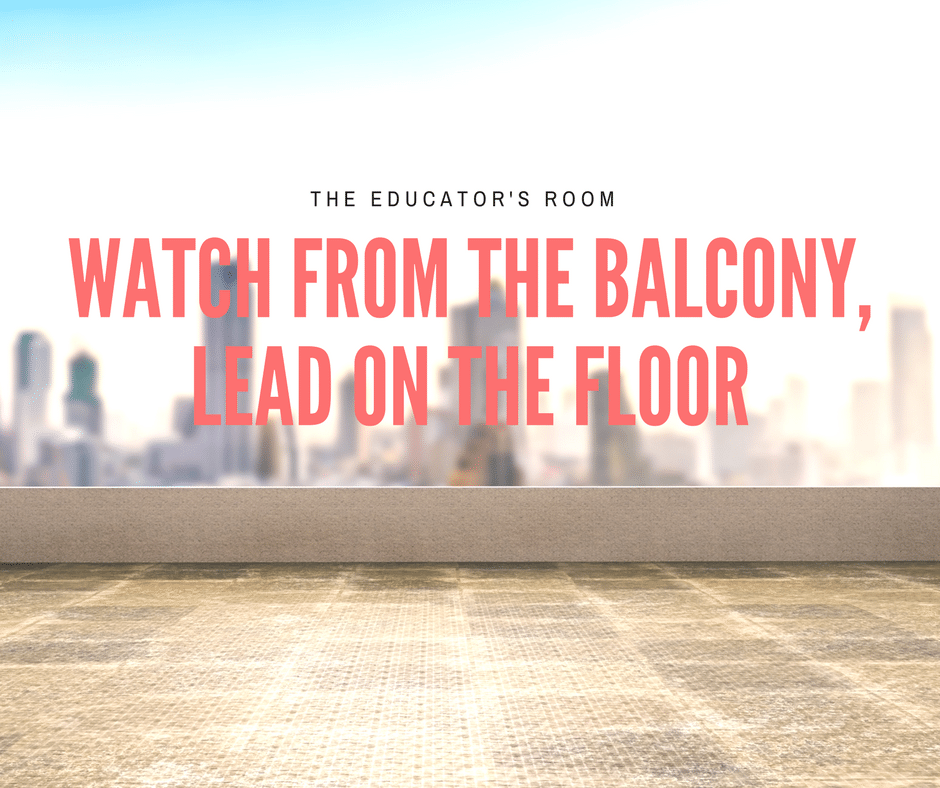School administrators spend most of their time on the dance floor, making tactical decisions; putting out fires, dealing with discipline and making sure the buses are running on time. On occasion, administrators have the opportunity to engage in professional learning. This learning is often focused on the ‘balcony view’ of leadership; strategy, rather than tactics. Much of the training and professional development for school/district leaders lacks the through-line from the balcony to the floor. “OK . . . I believe in shared leadership. I believe it is important.I want to lead my school that way . . . What steps do I take?”
[bctt tweet=”This learning is often focused on the ‘balcony view’ of leadership; strategy, rather than tactics. ” username=”EducatorsRoom”]
Let’s take this shared leadership scenario as an example. I once had a principal ask me how to build more of a shared leadership model in his school. Through conversation, he revealed to me that (as is typical) he had a few ‘go-to’ teachers who take on most of the school’s projects; often the most salient qualification being that they would say ‘yes’ when asked. We sat down with a list of his faculty and created a table of different skills and strengths that he would need to leverage during the school year.
For instance:
Innovators – often the creators and innovators are not the right people to convey the message
Mojo – who are the teachers with the social capital to move an innovation forward?
Communicators – who do people listen to?
Technology – who can throw together a video, meme, powerpoint, newsletter without breaking a sweat.
Organizer – charts, graphs, schedules, timelines are their forte
Cheerleader – this teacher can cheer, cajole and praise without patronizing.
He kept this chart in his desk, and when he called upon teachers to take on a leadership role, or when a teacher volunteered to do so, he made a note. The categories were fluid. Teachers could be in more than one category, and, as he got to know his faculty and their strengths and interests, he was able to efficiently and effectively share leadership in the school.
The column is designed to address real-life, real-time issues facing school leaders. We hope to receive questions from professionals in the field, who are stuck in between the dance floor and the balcony, and provide practical strategies to approach their particular scenarios.
To further that end, please take the time to complete this quick survey. The results will provide the foundation for the first few weeks of columns on school leadership.







In m last ten years as a teacher, I’ve seen a real drift in administration from school leaders who do their job (hire, manage funding) to school philosophers, who seem to want to “convert” everyone who works for them to the latest edufad buzzwords. There’s a huge disconnect between pie in the sky ideals and the hands-on, feet-on-the-ground work that teachers do, and too many administrators dismiss teachers who deal with the daily grind, as if our concerns are beneath them.
Honestly, the best thing that could happen in schools would be for every administrator to have to teach one class a day, forever. It’s the only way to keep fresh in your mind what the actual demands of the profession are.
You are so right!! Due to circumstances too long to go into, I found myself back in the classroom after a 5 year hiatus and it was the best thing ever for my leadership skills!